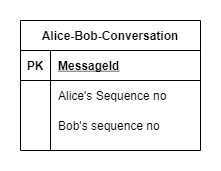I was asked this question in an interview and was unable to answer it.
How does FB messenger order the messages on user side when two messages are concurrent in order to avoid view difference in display order during the chat period and when user visits the messenger again. I thought that we can store a timestamp with each message, which is the time the message is received by the server. However, this will not ensure the correct ordering of messages for clients.
Take a scenario where the server timestamp cannot determine the exact order of messages would look like this:
- User-1 sends a message M1 to the server for User-2.
- The server receives M1 at T1.
- Meanwhile, User-2 sends a message M2 to the server for User-1.
- The server receives the message M2 at T2, such that T2 > T1.
- The server sends message M1 to User-2 and M2 to User-1.
- So User-1 will see M1 first and then M2, whereas User-2 will see M2 first and then M1.
I read that resolve this issue, we can use Vector clocks but was unable to understand how the message sequencing be preserved for different users during the chat and when users log in again.
In the above scenario, user1 will see M1 followed by M2 whereas user2 will see M2 followed by M1. Now if each user also generates a sequence number or timestamp for each of its message to each of the client (separately). Then in scenario above user1 will send message M1 with sequence <1 (user1 seq), 0(user2 seq) > and user2 will send message M2 with sequence <0 (user1 seq), 1(user2 seq) >. So when both the message arrives at user1 and user2 they will have: M1 <1, 0> M2 <0, 1>
Now let’s say user1 sends more messages M3 <2, 1> and M4 <3, 1> then each of client will have following msgs. M1 <1, 0> M2 <0, 1> M3 <2, 1> M4 <3, 1>
So in this case when the user is logged in the display order for user-1 and user-2 during chat will be M1,M2,M3,M4 and M2,M1,M3,M4 respectively. Now, I want to know how will the same order be preserved for user-1 and user-2 end when the login again ?
Thanks.

